Théodore Géricault: Celebrating the Great French Artist

- SUBSCRIBE
- ALREADY SUBSCRIBED?
BECOME A BONJOUR PARIS MEMBER
Gain full access to our collection of over 5,000 articles and bring the City of Light into your life. Just 60 USD per year.
Find out why you should become a member here.
Sign in
Fill in your credentials below.
This week marks the 200th anniversary of the death of Théodore Géricault. He was the foremost artist of the Romantic era of French painting, almost single-handedly establishing the genre. His award-winning paintings were some of the most important pictures of his time, but his dark genius was condensed into a few short years. He passed away on January 26, 1824, at the early age of 32.
Géricault was born in Rouen in 1791 as France was in the grip of revolution. His wealthy, land-owning parents moved to Paris where he plodded through his education at Lycée Impérial (now Lycée Condorcet at 8 rue du Havre). Despite his father’s disapproval, Géricaul pursued artistic training — a generous annuity bequeathed by his mother awarded him financial independence.
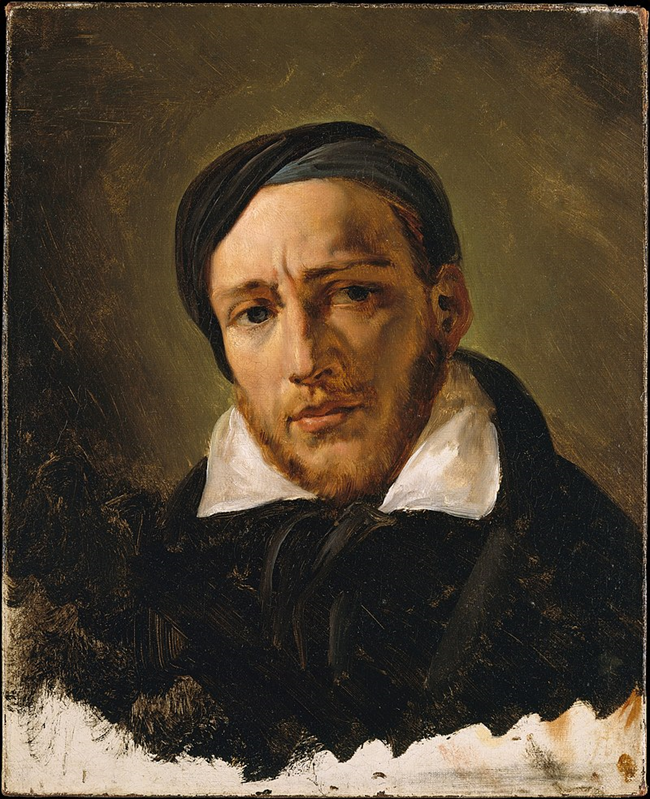
Horace Vernet painting of Jean-Louis-André-Théodore Gericault, 1822 or 1823. Image Credit: Public Domain/Wikimedia Commons
Géricault entered the studio of Carle Vernet, a painter of the modern military genre which featured Géricault’s lifelong obsession – horses. Here he developed a remarkable talent for capturing animals in movement. In February 1811, he entered the École des Beaux-Arts, but quit to copy the old masters at the new Musée Napoléon (an early incarnation of the Louvre). This was also short lived because he was permanently banned from the museum for assaulting a fellow student there in 1812.
However, his first exhibit at the Paris Salon of 1812, The Charging Chasseur, now hangs at the Louvre. The huge painting of a fearful Napoleonic guard was completed in a nearly impossible 12 days. Though the painting earned him a medal, the painting wasn’t purchased by the French state. A subsequent painting exhibited in 1814, The Wounded Cuirassier Leaving the Battle, fared no better, perhaps because it represented Napoleon’s battlefields in a less-than-flattering light. Géricault was dissatisfied with the finished painting saying it lacked his personal experience of suffering.
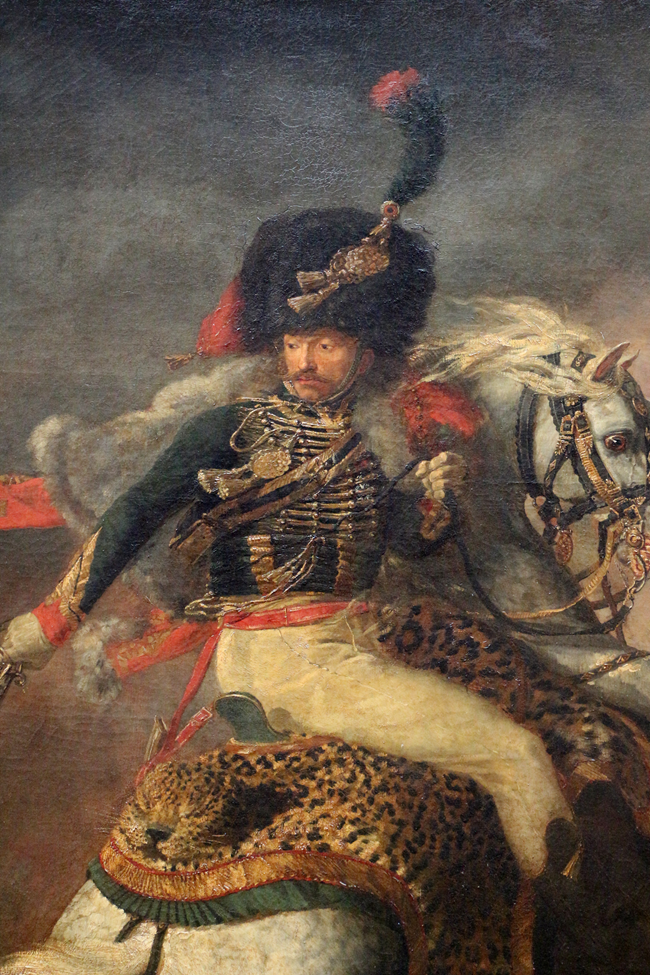
Théodore Géricault, The Charging Chasseur, 1812. Credit: Sailko/Wikimedia Commons
He did his own time in the French army. However, it coincided with the 100 days that the run-away Napoleon recaptured the crown. Géricault spent most of his time as a member of the National Guard in exile with the the king’s men guarding Louis XVIII.
When released from military service, he became part of the artistic circle. He was a stylish, handsome fellow who was well aware of his good looks. Tall, and a bit of a dandy, he secretly used paper curlers to make his naturally straight hair more fashionably wavy. A more serious secret was his affair with the very young wife of his mother’s brother. (Note: There was no blood relationship, and Alexandrine-Modeste was much closer to Géricault’s age than that of his uncle.)

Théodore Géricault, Riderless Racers at Rome (1817). Baltimore, Walters Art Museum. Wikimedia Commons
Géricault resolved to begin a vigorous program of self-education. In the book The Victorian Visitors, Rupert Christiansen recounts Géricault’s detailed to-do list: “draw and paint the great masters of the ancient world; Read and compose. Anatomy. Antiquity. Music. Italian. Busy myself solely with the style of the Old Masters and compose without going out and remaining alone.” But leave the house he did.
To better understand the masters of the ancient world, he did what many artists of that time did – he headed to Rome. Apart from studying the classic masterpieces, the real-life races of the riderless Barberi horses absorbed his interest. He painted these wild horses over 50 times.
While laboring over these equestrian paintings, Géricault was obliged to deal with another kind of labor – the birth of his son, Georges-Hippolyte, in the summer of 1818. Initially raised by foster parents, the boy was recognized by his grandfather as part of the Géricault family after the painter’s death five years later. Théodore Géricault would never see Alexandrine again.
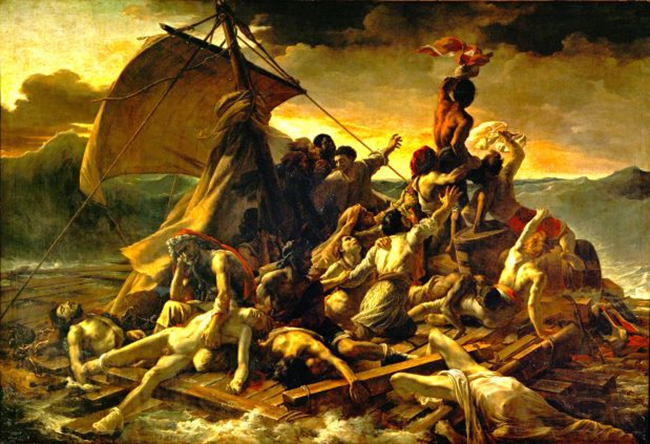
Théodore Géricault, The Raft of the Medusa, 1819. Credit: The Louvre/ Wikimedia Commons
Prior to this family scandal, Géricault had started working on what would become his masterpiece, The Raft of the Medusa, portraying a real-life event. It was a scandal of greater proportions. In 1816, the ship Medusa ran aground on its way to Senegal, ironically not far from shore, and 149 passengers were unable to fit in the lifeboats. They were assembled on a raft to be towed behind the ship. After failed attempts to move the raft, sailors cut the ropes, leaving it adrift. After one month at sea, all sorts of grisly horrors ensued, including, delirium, violence, suicides, and cannibalism. All but 15 died. Two of the survivors published accounts of their ordeals.
Géricault studied every aspect of the gruesome story. He interviewed the survivors, some of which he used as models. He met the ship’s carpenter who made a model of the doomed raft in Géricault’s studio. He took a workroom near a hospital so he could study corpses and the dying. As training, he painted severed heads, hands and feet, now startlingly on display at the Beaux-Arts Museum in Rouen. Wielding artistic license, he added another four bodies.
Géricault’s Raft was a massive 5m high by 7m wide. The equally impressive subject matter consists of a huddle of figures, representing death, grief, despair, resignation, and above all, hope. The painter himself is the model for the man at the apex of the painting. Géricault had a romantic notion that reality didn’t have to be beautiful. The work was a complete break from Classicism.

Study of Hands and Feet, Études de mains et pieds (1818-1819), Montpellier, musée Fabre. Credit: Wikimedia Commons
Art historian Kenneth Clark in his Romantic Rebellion: Romantic Versus Classic Art had another romantic notion: that Géricault was so handsome that he shaved his head to stave off unwanted attention from women. What’s more likely is that when Géricault began the final painting, he isolated himself monastically in his studio and shunned vanity in order to concentrate on his work. However, to put a romantic spin on it, such an intense gesture for a vain man may symbolize the grief for his lost love.
Through this period of self-confinement, Géricault’s closest companion was his 18-year-old assistant Louis-Alexis Jamar. Their relationship was stormy and emotional. They quarreled, embraced, and pouted like a married couple. It was Jamar who noticed Géricault’s work habits.

Théodore Géricault, Étude de portrait pour Joseph (vers 1818-1819), Los Angeles, Getty Center. Wikimedia commons
Géricault’s teachers once told him he wasn’t cut out to be a painter. He wasn’t calm and restrained enough to follow in the footsteps of Classicism. But what Jamar saw was a quiet, diligent man who set up his canvas slowly and then painted very rapidly. Despite the speed, Géricault remained calm. Jamar observed that the arrangement on his master’s palette was almost the same at day’s end, as if it was unused.
The actual shipwreck had scandalous political implications in France. The incompetent, arrogant captain, who hadn’t set to sea for decades, gained the position because of political connections. He saved himself while leaving the lower ranks to die. Géricault’s raft painting was met with hostility by the Bourbon government who felt it was too early for such contemporary reportage to be represented as a heroic/tragic work of art.
Nonetheless, when the Raft of the Medusa was shown at the Paris Salon of 1819, Géricault’s new point of view drew the attention of the public. Art didn’t have to be pretty to be appreciated, it could be dark, even grotesque. Emotional theatricality won out. This was Romanticism with a capital R. Some painters like Ingres hated his work and wanted it removed from the Salon of 1819. They thought it was corrupting. The work earned Géricault a gold medal, but it wasn’t purchased by the state for the Louvre’s national collection.
Géricault arranged for the Raft of the Medusa to be exhibited in London in 1820, where it was shown at William Bullock’s Egyptian Hall where it was viewed by about 40,000 visitors who paid a shilling for the privilege. Museums as we know them today weren’t then as fashionable or organized, and often great works were shown in these private exhibition spaces.
Géricault liked London and stayed for a year, immersing himself in city life. He liked the buzz of London and socialized with English artists. He relentlessly sketched horses, their fashionable horsemen and grooms. However, the Derby at Epsom is his only major painting from his time there.
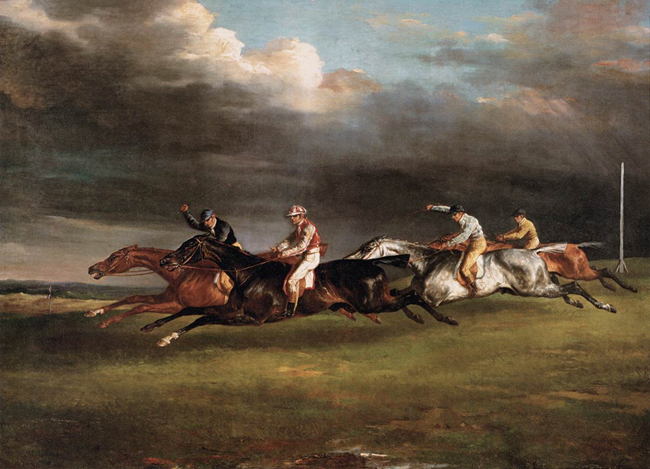
Théodore Géricault, The Derby at Epsom, 1821. Credit: Public Domain/Wikimedia Commons
Géricault was also moved by the plight of the poor beggars on London’s streets and created a series of prints featuring them. He fell into despondency and tried to take his own life. On his return to Paris in the winter of 1821, his mood worsened; he was sick and sadder than ever. He had a commission to paint 10 paintings illustrating the physiognomies of the insane. One, Mad Woman also known as the Hyena of Salpêtrière, is exceptional in its realism and one of the most important, expressive portraits ever painted. Again, he captured reality by leaving all traces of the picturesque behind.
Throughout 1822, Géricault kept up both his social life and his painting, but he was doomed to experience the suffering he once depicted. His subject matter may have exacerbated his sickness. Some scholars say Géricault died from an infection of the spine resulting from a riding injury, but he most likely succumbed to tuberculosis of the spine. He may have been exposed to tuberculosis bacteria during his frequent visits to the asylum, as well as visits to the wards of the terminally ill.
In the latter part of 1823, his physical condition worsened rapidly. While on his deathbed in the autumn of 1823, the director of the Louvre was finally authorized to buy the Raft of the Medusa for the museum. Géricault was a genius and recognized as such from his first attempts. His life wasn’t long enough to develop a legacy. What could he have accomplished had he lived longer?
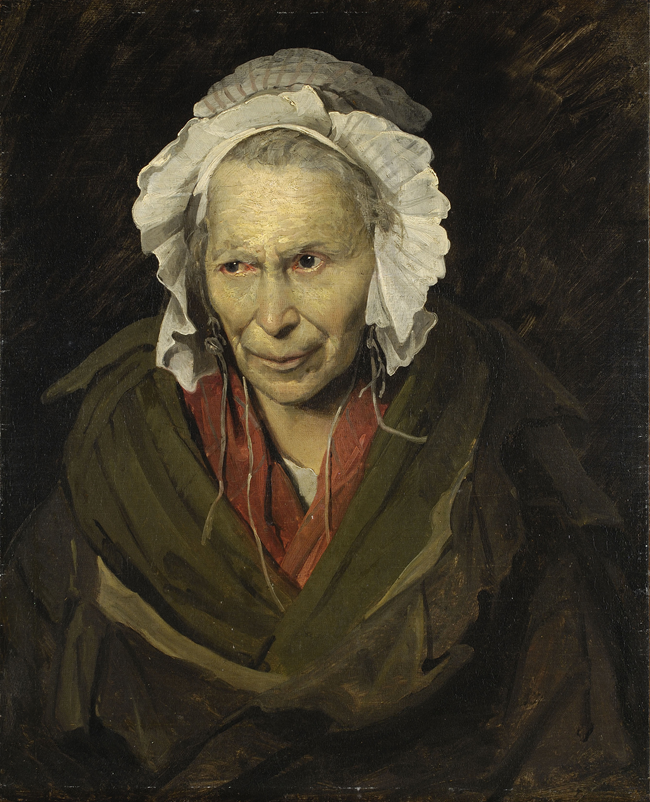
Théodore Géricault, Portrait of a Woman Suffering from Obsessive Envy (French: La Monomane de l’envie), 1822 (Museum of Fine Arts of Lyon). Public domain
Lead photo credit : Théodore Géricault, The Race of the Riderless Horses, 1817. Credit: J. Paul Getty Museum / Wikimedia commons
More in Art, French artists, history
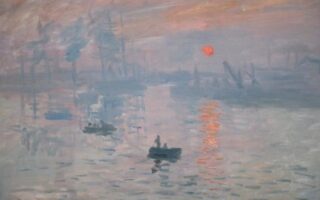


REPLY